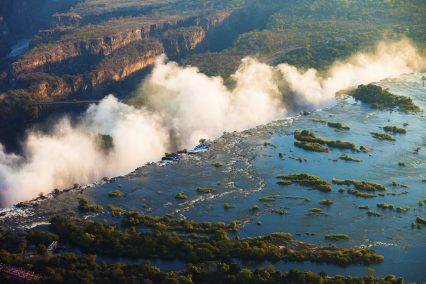From the start, the international mining company, Equinox Minerals, has been a besotted suitor for Zambia’s Lumwana copper field. Where five other companies had tested Lumwana and found it lacking, judging the concentration of copper too low and the site too remote, Equinox put in a processing plant and laid down 150km of road. While competitors sent miners deeper and deeper into the earth, along the seams of Zambia’s legendary copperbelt 220km to the east, Equinox sunk a billion US dollars into two greenfield mines at Lumwana over the course of 10 years, planning two open-pit mines, trained local workers to operate heavy equipment and built a town, complete with schools and libraries, for hundreds to call home.
The rationale was that thinking big was the only way to make Lumwana viable.
“The concentration of copper in Lumwana is about a quarter of what you would find in the copperbelt,” says Harry Michaels, a vice-president at the Australian Equinox Minerals. “It was inaccessible. If you couple those things, it’s no surprise other investors came and said it would be too hard. One way to overcome that was making it larger and getting some benefit out of economies of scale – but that meant we had to invest a lot up front.”
Investing in copper up front is not for the faint of heart. Over the course of the past decade, prices rose to record heights on the promise of emerging giants in the East, only to plummet to below the average cost of production in early 2008. Thousands of miners were laid off as mines shut down. Unions threatened to strike. In August last year, Zambian President Levy Mwanawasa, long a dependable ally to mining companies and a dogged fighter of corruption, died unexpectedly. In campaigns that followed, proposals to compel mines to hand over 25% of their shares to local investors found substantial support, throwing a pall of uncertainty over an already beleaguered sector.
“There was a very long period of uncertainty, during which it wasn’t clear what the regime was going to be,” says John MacNamara, head of structured trade finance at Deutsche Bank. “Uncertainty drives prices of production up. Companies wait to upgrade. If you want to buy that new pump you’re going to wait.”
End of boom times
The collapse in prices came on the heels of a boom.
In 2006, copper prices soared, from US$2,800 a tonne at the end of 2005 to hit US$8,800 a tonne the following year. This peak was reached again in 2008.
Every kind of mining seemed to be worthwhile. Old operations were resuscitated. Zambia’s decrepit power supply shuddered under the pressure to produce, but miners flush with cash simply built new generators and imported fuel at great expense. In some mines, the cost of production for one ton of copper passed US$5,000.
“There are mines that have been around for the past 40 to 50 years and they are quite mature now,” says Nathan Chishimba, president of Zambia’s Chamber of Mines, who is also an employee of Lumwana Copper Mine. “It becomes increasingly expensive to extract production from them and that’s why they are among the highest cost mines in the world.”
With open-pit mines and cutting edge technology, Lumwana’s copper would be ready for the smelter at considerably lower cost – under US$1,700 per tonne.
By November 2006, Equinox had raised US$583.8mn for the project. It was one of the largest financing packages ever raised by a junior resources company.
But 14 months later, the Zambian government raised royalties and instituted a windfall tax on copper, effectively increasing mining taxes from 31% to 47%. Miners complained that Zambia was breeching contracts and sullying a reputation as one of Africa’s most hospitable destinations for foreign direct investment. Still, President Mwanawasa was considered a staunch ally to the private sector and mining in particular. In the spring of 2008, copper prices hit a record US$8,750 per tonne.
And, though mining had yet to begin, and in spite of higher taxes, Equinox seemed to be poised at the sweet spot of Zambia’s mining industry.
“Zambia should move towards encouraging more greenfield development,” says Chishimba, “It’s lower cost, better technology, more jobs, and more economic activity for the country.”
The promise of 16 million tons of uranium was an added bulwark against volatile copper prices.
Then, in August, President Mwanawasa died. The global economic crisis cut demand in Europe and the US and, in the fall, prices sank to under US$3,000.
Mining accounts for 63% of Zambia’s export income and, as investors from the West began to pull back, halting operations where the cost of production was high, populist electioneering threw a further shadow over the industry.
“Because of the huge escalation over the previous two years in copper prices, governments all around the world were revisiting contracts in all kinds of commodities,” says Stephen Capon, head of country and credit risk management at Ace Global Markets. “Quite frankly, if you look at the tax breaks that had been given, it had been an incredibly benign environment. On top of that you had an election coming up. The combination of the two was creating a lot of sound bites from both parties with regard to what they were or were not going to do.”
China fills the void
Only Chinese demand, which accounts for 27% of Zambian copper exports, held.
Though predictions for growth in India and China were tempered somewhat with the global crisis, state-sponsored investment in Africa continued apace. China, with its sights set on a long-term programme of national growth, stayed in the market, stockpiling copper at low prices.
“The Chinese are making deals from a different strategic rationale,” says Deutsche Bank’s MacNamara. “When we finance deals it’s because the Zambian counterparty is our partner. When the Chinese come in, what they want is 20 or more years of copper supply.”
Though Zambia had soured somewhat on Chinese companies, which have a reputation for low safety standards, poor labour conditions and frigid relations with neighbouring communities, the more than 8,000 layoffs in the industry over the past year cast China in an altogether rosier light.
In January, Luanshya Copper Mine (LCM), a joint venture of the Swiss-based International Mineral Resources and Bein Stein Group Resources of Israel, stopped operations, leaving 1,700 miners out of work.
Some of the miners’ wives petitioned Zambia’s new president, Rupiah Banda, to find a buyer or for the government, which owns 15% of the shares, to take over LCM. Mining companies wondered whether Banda could hold to statements saying the government would take a 25% stake in new mining deals.
Six months later, President Banda announced that China’s Non-Ferrous Metals Mining Company (NFCA) had won a contract to run LCM.
“This investor is not in Zambia just to make quick money and get out at the first sign of stress in the business,’’ Banda said at the time.
The award, which passed over a bid by the London-listed metal and mining company Vendata Resources, which runs the biggest copper mine in the country, Konkola Copper Mines (KCM), as well as Luanshya Mineral Resources, provoked protests from some Zambians who remembered a 2005 accident in another NFCA-owned mine that left 49 workers dead.
In the end, it was a business decision.
“The world is changing and we have to accept that capital is mobile,” says Chishimba. “As long as everybody is following the same standards I don’t see a problem where the money is coming from.”
In spite of earlier promises, the government settled for just 15% of LCM.
“It makes sense to favour the people who have got the money,” says MacNamara. “The Chinese are making a very compelling case for dealing with China these days.”
When Glencore International stopped operations at another mine with high production costs, Banda threatened to take control of the mine. Political risk experts remained unfazed.
“Zambia wouldn’t be the only country on the planet where, if they feel the investor is not performing or may shut something down, the government could well interfere and we’ve seen that carried out,” says Ace Global’s Capon. “A lot of people believe that by the end of the day this government will end up working quite pragmatically with investors.”
In the end, the mine’s management acquiesced, making internal adjustments to cut the cost of production.
Kept in the dark
According to Capon and others, the biggest drag on Zambian mining is not fluctuating policy, but a shortage of infrastructure. Zambia is landlocked and shipping copper out means crossing through sleepy customs houses on several borders and processing exports through decrepit, congested ports in Mombasa and Dar es Salaam. And then there is the problem of electricity.
As prices rose on the back of China’s infrastructure-focused stimulus package this spring, the country’s biggest copper mine, Konkola, promised it would double its copper output to 305,000 tons. Lumwana already has signed offtake contracts to deliver 150,000 tons of copper contained in concentrates to smelters in the region.
But there are real physical obstacles to such a boom spreading across the sector.
“The most immediate threat to the industry is power supply,” Capon says.
In early June, weeds drifting on the Kafue River, one of Zambia’s principal rivers, siphoned water from a hydroelectric dam, causing days of blackouts and costing miners millions. Zambia went dark again two weeks later, when a transformer caught fire and knocked the nation’s beleaguered system down once more.
The state power utility, Zesco, rushed to import power from neighbouring Democratic Republic of Congo and Namibia, but it wasn’t enough to keep mines in operation. In the second blackout alone, Equinox lost US$1.8mn in revenue or the equivalent of 500 tonnes in copper production.
Like other companies, Equinox has a long-term power supply offtake agreement with Zesco.
If mines are to double output, they will have to import far more diesel fuel for generators while Zesco brings the power supply up to speed.
Equinox’s Michaels is confident Zambia can use its mineral wealth to overcome hurdles like this. Already, the road network for the mine has spawned other businesses, including flowers grown for export to Europe.
“I’ve never seen anything in my life like the discovery of a mineral deposit that can transport an area in terms of development,” he says. “In a country like Zambia, the fastest way to develop is through more and more Lumwanas.”





